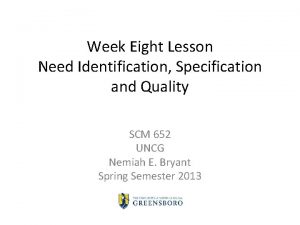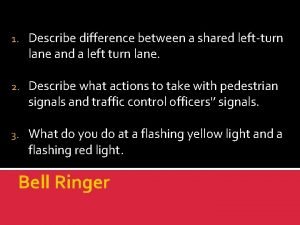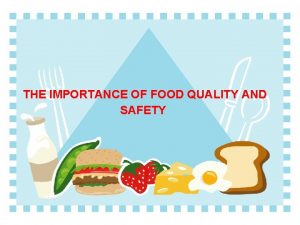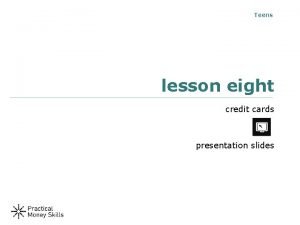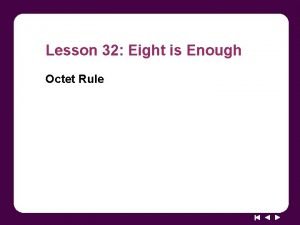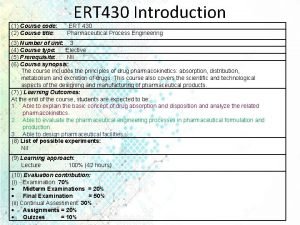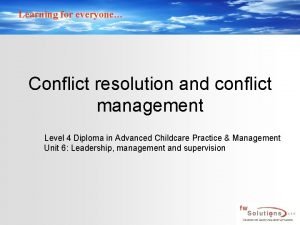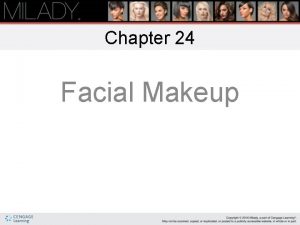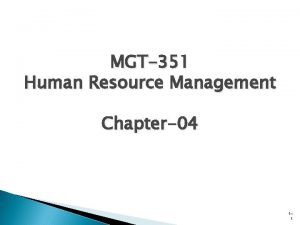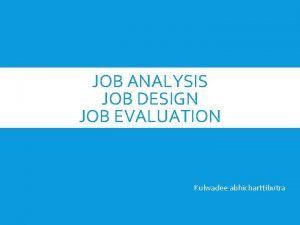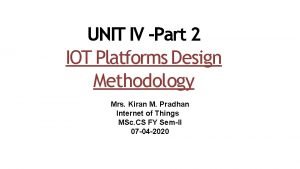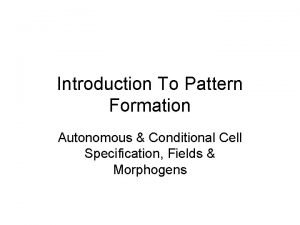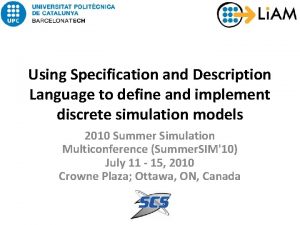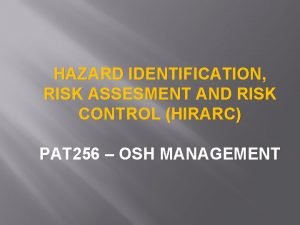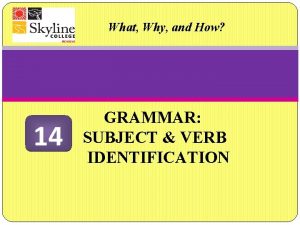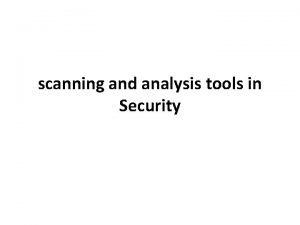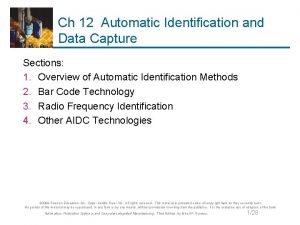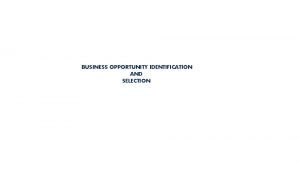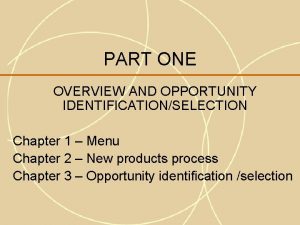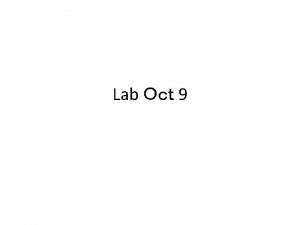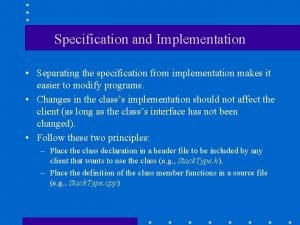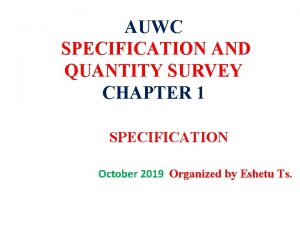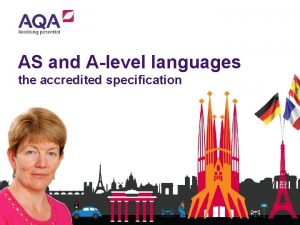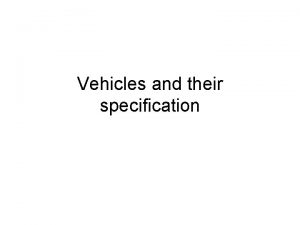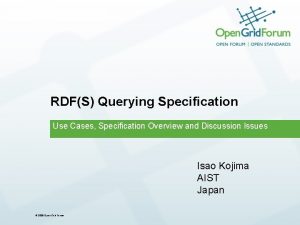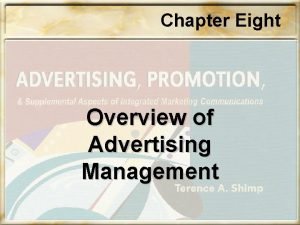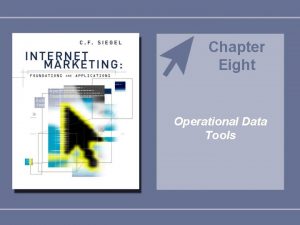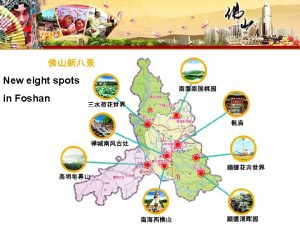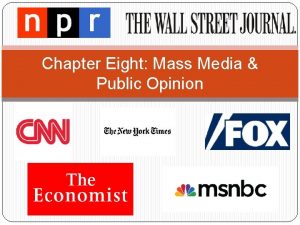Week Eight Lesson Need Identification Specification and Quality

















































- Slides: 49

Week Eight Lesson Need Identification, Specification and Quality SCM 652 UNCG Nemiah E. Bryant Spring Semester 2013

Need Identification Criteria • Strategic – e. g. , total spend, risk reduction, access to new technology or new markets, assurance of supply in tight markets, etc. • Traditional supply criteria – quality, quantity, delivery, price and service • Additional current criteria – financial, risk, environmental, innovation, regulatory compliance and transparency, social and political factors

Categories of Needs Category Description Resale Resellers comprise retailers, wholesalers, distributors, agents, brokers and traders. What they can resell covers the full range of the remaining categories. Raw and Semi. Processed Materials Most users of materials are converters, such as factories, and this category includes commodities, agricultural and industrial. Parts, Components and Packaging Assemblers use parts and components produced by their suppliers to create a finished product. Parts and components may be standard or special depending on the decision of the designer of the finished product.

Category Categories of Needs Description MRO and SVP Every organization has MRO requirements and SVP’s. The availability of MRO suppliers is critical to maintain continued uninterrupted operation of the office, factory, facility, etc. Because many MRO requirements are relatively small in dollar value, SVP’s are also included in this category. For SVP’s assuring availability at minimum acquisition cost is a challenge. Capital Any requirement that accountants classify as capital, and, therefore, an investment, becomes a capital item. Equipment, IT, real estate and construction are included in this category. Capital items can be depreciated, are often bought under a separate budgetary allocation and may require special financing arrangements.

Categories of Needs Category Services Description Every organization acquires a variety of services. Other Anything not covered by the above categories falls into this last one. Major requirements could be energy and water. This category would also include unusual and infrequent requirements, probably better dealt with on an ad hoc or project basis.

Special Problems of Equipment Purchasing • • • Strategic considerations and high cost of failure Substantial amounts of money for a single purchase Long life and infrequent purchases Difficulty estimating the total cost Derived demand Environmental impact and disposal Significant tax considerations Technology forecasting Dedication of time and resources during start-up Commitment to process, cost, product line and plant space Coordination with existing processes and operations

Reasons for the Purchase of Capital Goods • • Capacity Economy in operation and maintenance Increased productivity Better quality Dependability in use Savings in time or labor costs Durability Safety, environmental and emergency protection

Source Selection for Capital Goods Purchases • Total cost of ownership (TCO) analysis – Purchase cost may only represent 20 to 60 percent of TCO • Engineering Service – Presale and postsale service • Design and R&D capabilities and costs • Legal considerations – patents, liability for lost sales, health & safety • Disposal at end of useful life

Reasons for Lack of Supply Involvement in Service Acquisition • Complexity of specifying service needs and analyzing potential service provides means that the user has greater expertise than purchasing • The buying of services involves more of a personal relationship between the supplier and user. • Many services in the past have been available only in a regulated environment, in which price and servicedelivery was essentially the same for all suppliers

What Makes Services Different? • Intangible – Cannot touch it • Perishable – no inventories • Heterogeneous: The “service package” – high levels of customization • Customer participation in the production process • Simultaneous production and consumption • Difficult to measure quality

Opportunity to Affect Value High Opportunity to affect value Low 1. 2. Need Description recognition 3. Potential suppliers 4. Selection 5. Receipt Acquisition Process Steps 6. Payment

Methods of Description • By brand • “Or Equal” • By specification – Physical or chemical characteristics – Material or method of manufacture – Performance • By engineering drawing • By miscellaneous methods – Market grades – Sample • By a combination of two or more methods

When Description by Brand is Desirable • Either the manufacturing process is secret or because the item is covered by a patent • Specifications cannot be laid down with sufficient accuracy • The quantity bought is so small • End customers or users have preferences in favor of certain branded items

Advantages of Buying with Specifications • Evidence exists that thought and careful study have been given to the need and the ways in which it may be satisfied • A standard is established for measuring and checking materials as supplied, preventing delay and waste that would occur with improper materials • An opportunity exists to purchase identical requirements from a number of different sources of supply • The potential exists for equitable competition • The seller will be responsible for performance when the buyer specifies performance

Limitations in Using Specifications • There are requirements for which it is practically impossible to draw adequate specifications • The use of specifications adds to the immediate cost • The specification may not be better than a standard product • The cost is increased by testing to ensure that the specifications have been met • Unduly elaborate specifications sometimes result in discouraging potential suppliers from placing bids in response to inquiries • Unless the specifications are of the performance type, the responsibility for the adaptability of the item to the use intended rests wholly with the buying organization • The minimum specifications set up by the buying organization are likely to be the maximum furnished by the supplier

Standardization and Simplification • Standardization: Agreement on definite sizes, design, quality, or other aspects of the product or service. – A technical and engineering concept • Simplification: A reduction in the number of sizes, designs or other aspects of the product or service. – It is a selective and commercial problem – It may be applied to articles already standardized or as a step preliminary to standardization

Week Eight Lesson Need Identification, Specification and Quality SCM 652 UNCG Nemiah E. Bryant Spring Semester 2013

Market Niches for Quality Better than Competitors Same as Competitors Lower than Competitors

Eight Dimensions of Quality 1. Performance: The primary function of the product or service 2. Features: The bells and whistles. 3. Reliability: The probability of failure within a specified time period. 4. Durability: The life expectancy. 5. Conformance: The meeting of specifications. 6. Serviceability: The maintainability and ease of fixing. 7. Aesthetics: The look, smell, feel, and sound. 8. Perceived quality: The image in the eyes of the customer.

The Traditional View of Quality-Cost Trade-off

The Current View of the Quality-Cost Trade-off

Five Major Cost of Quality Categories • Prevention costs • Appraisal costs • Internal failure costs • External failure costs • Morale costs

Total Quality Management • Quality must be integrated throughout the organization’s activities • There must be employee commitment to continuous improvement • The goal of customer satisfaction, and the systematic and continuous research process related to customer satisfaction, drives TQM • Suppliers are partners in the TQM process

Objectives of Quality Function Deployment • Seeks both spoken and unspoken customer needs • Identifies positive quality and business opportunities • Translates these into actions and designs by using transparent analytic and prioritization methods • Empowers organizations to exceed normal expectations

The Four Integrated Stages of Quality Function Deployment • Product planning - to determine design requirements • Parts deployment - to determine parts characteristics • Process planning - to determine manufacturing requirements

The Role of Suppliers in QFD • Product planning - Provide expertise in analyzing customer requirements and generating a list of new product ideas • Parts deployment - Provide alternative design concepts and estimate the manufacturing costs of various parts • Process planning - Suppliers can determine their existing processes’ constraints • Production planning - Help develop

Common Elements of Lean Six Sigma ● The Lean Six Sigma strategy helps to increase production speed while decreasing production variations. ● The fusion of Lean and Six Sigma improvement methods is required because: Lean cannot bring a process under statistical control. Six Sigma alone cannot dramatically improve process speed or reduce invested capital. Both enable the reduction of the cost of complexity. ● Lean Six Sigma uses the DMAIC (Define, Measure, Analyze, Improve, Control) Process

Common Elements of Lean Six Sigma ● Lean: • Focuses on maximizing process speed • Analyzes process flow and delay times for each activity in a process • Eliminates the root causes of “non-value added” activities and their cost • Provides a means for quantifying and eliminating the cost of complexity Six Sigma: • Eliminates defects, as defined by customers, using statistical methods • Identifies variability in manufacturing and removes the cause(s) • Uses data driven decisions and quality tools for effective problem solving • Provides a rigid cultural infrastructure effective in obtaining sustainable results • Utilizes teams of experts to take control of problems and implement solutions.

Process Control • Process capability - The ability of the process to meet specifications consistently • Causes of variation - Common causes and special/assignable causes • Statistical process control (SPC) - A technique that involves testing a random sample of output from a process in order to detect if nonrandom changes in the process are occurring – common causes versus special or nonrandom causes

Service Quality Evaluation • Reliability: Ability to perform the promised service dependably and accurately • Responsiveness: Willingness to help customers and provide prompt service • Assurance: Knowledge and courtesy of employees and their ability to inspire trust and confidence • Empathy: Caring, individualized attention the firm provides its customers • Tangibles: Physical facilities, equipment and appearance of personnel

A Framework for Analyzing Services • Value of the service – high, medium low – Pareto/ABC analysis • Degree of repetitiveness – repetitive versus unique • Degree of tangibility – Low versus high • Direction of the service – Directed towards people or assets

A Framework for Analyzing Services • Production of the service – People, equipment or people and equipment – Skill level of people • Nature of demand – Continuous, periodic or discrete • Nature of service delivery – Location, time • Degree of standardization – Standard or customized • Skills required for the service

Quality Standards and Awards • ISO 9000 – International consensus on good quality management practices consisting of standards and guidelines relating to quality management systems and related supporting standards • ISO 14000 – Similar to ISO 9000 in management principles – Focuses on environmental issues • The Malcolm Baldrige National Quality Award – Annual award for U. S. organizations in business, health care, education and nonprofit – Recognizes excellence in quality achievement and quality management

Supplement Supply Chain Risk Management SCM 652 UNCG Nemiah E. Bryant Spring Semester 2013

Supply Chain Risk 1. Creation, the idea or design function, frequently based on research and development 2. Finance, the capital acquisition, financial planning and control function 3. Personnel, the human resources and labor relations function 4. Supply, the acquisition of required materials, services, and equipment 5. Conversion, the transformation of materials into economic goods and services 6. Distribution, the marketing and selling of goods and services produced 1 -35

Types of Supply Chain Risks • Financial (Credit, Market, Liquidity) • Strategic (SWOT (Internal environment), macro-economic environment, business and supply chain strategy, industry environment) • Hazard Risk (Natural and Man-Made Disasters) • Operational (People, processes, systems) • Regulatory (Laws, Environment) • Reputational (Brand, Image) 1 -36


Sources of Supply Chain Risks

Enterprise Risk Management (ERM) • Defined by an entity’s board of directors, management or other personnel, applied in strategy setting and across the enterprise, designed to identify potential events that msy effect the entity, and manage risk to be with its risk appetite, to provide reasonable assurance regarding the achievement of entity objectives. 1 -39

Components of ERM • • • Internal & External Environment Risk Appetite Objective Setting Event Identification Risk Assessment Risk Response Control Activities Information and Communication Monitoring 1 -40

Components of ERM • Internal Environment – Encompasses the tone of an organization, and sets the basis for how risk is viewed and addressed by an entity’s people, including risk management philosophy and risk appetite, integrity and ethical values, and the environment in which they operate. • Includes: – Company’s risk management philosphy – Risk appetite – Board of Directors – Integrity and Ethical Values – Organizational Structure – Human Resource Standards – Assignment of authority and responsibility – Commitment to competence 1 -41

Components of ERM • Objective Setting – Objectives must exist before management can identify potential events affecting their achievement. Enterprise Risk Management ensures that management has a process in place to set objectives and that the chosen objectives support and align with the entity’s mission and are consistent with its risk appetite 1 -42

Components of ERM • Event Identification – Internal and external events affecting achievement of an entity’s object ives must be identified, distinguishing between risks and opportunities, Opportunities are channeled back to management strategy or the objectivesetting processes. 1 -43

Components of ERM • Risk Assessment – Risk are analyzed, considering likelihood and impact, as a basis for determining how they should be managed. Risks are assessed on an inherent, control and residual basis, with the assessment considering both likelihood and impact • Risk Response • Control Activities • Information and Communication • Monitoring 1 -44

Risk Strategies and Decisions • Strategy Categories – Risk Mitigation – Contingency planning – Business Insurance • Risk Decisions – Avoid the risk – Transfer the risk – Retain the risk – Reduce the risk 1 -45

Supply Chain Risk Mitigation Strategies • Traditional SCM Mitigation Techniques – Operational Execution – Credit Tools (Due diligence, Financial Analysis, credit decisions, letter of credit, bonds) – Security (Physical and Cybersecurity) – Strategy Alignment – Inventory – Capacity Planning – Dual Sourcing/Vendor Management – Long Term Contracts/Hedging – Insurance – Business Continuity Planning 1 -46

Supply Chain Risk Mitigation Strategies • Flexible Mitigation Techniques – Generic raw material inventory – Product Postponement – Flexible distribution and logistics alternatives – Cross Training of Employees – Supply Chain Visibility – Redundancy 1 -47

Supply Chain Risk Mitigation Strategies • Flexible – Generic raw material inventory – Product Postponement – Flexible distribution and logistics alternatives – Cross Training of Employees – Supply Chain Visibility 1 -48

Incoterms (A visual example)
 Uncg erm
Uncg erm A polygon with eight sides and eight angles
A polygon with eight sides and eight angles What are the meanings of the eight shapes and eight colors
What are the meanings of the eight shapes and eight colors Upper specification limit and lower specification limit
Upper specification limit and lower specification limit Natural variations operations management
Natural variations operations management Central pocket whorl vs plain whorl
Central pocket whorl vs plain whorl Customer need adalah
Customer need adalah Week by week plans for documenting children's development
Week by week plans for documenting children's development Why is food quality important
Why is food quality important Lesson eight credit cards
Lesson eight credit cards Eight is enough octet rule
Eight is enough octet rule Quality control and quality assurance
Quality control and quality assurance Basic concept of quality control and quality assurance pdf
Basic concept of quality control and quality assurance pdf This week's lesson
This week's lesson Lesson plan for revision week
Lesson plan for revision week Last week's lesson
Last week's lesson Quality management pmp
Quality management pmp What are quality standards in project management
What are quality standards in project management Quality assurance model in nursing management
Quality assurance model in nursing management Quality improvement vs quality assurance
Quality improvement vs quality assurance Quality gurus
Quality gurus Crosby quality is free
Crosby quality is free What is tqm
What is tqm Starting from rest a marble first rolls down
Starting from rest a marble first rolls down 8 vertices and 6 faces.
8 vertices and 6 faces. Bell and hart's eight causes of conflict
Bell and hart's eight causes of conflict Chapter 24 facial makeup review questions
Chapter 24 facial makeup review questions Eight brief tales of lovers
Eight brief tales of lovers Forty and eight
Forty and eight Difference between macro and micro lesson plan
Difference between macro and micro lesson plan Sat vocabulary lesson 4
Sat vocabulary lesson 4 Lesson outline lesson 1 solids liquids and gases answer key
Lesson outline lesson 1 solids liquids and gases answer key Lesson 4 gravity and motion lesson review
Lesson 4 gravity and motion lesson review Lesson outline lesson 1 magnets and magnetic fields
Lesson outline lesson 1 magnets and magnetic fields The sun-earth-moon system worksheet answers lesson 1
The sun-earth-moon system worksheet answers lesson 1 Participant diary/log
Participant diary/log Analyze vs evaluate
Analyze vs evaluate Embedded iot platform design methodology
Embedded iot platform design methodology Conditional and autonomous specification
Conditional and autonomous specification Sdl specification and description language
Sdl specification and description language Software requirement analysis and specification
Software requirement analysis and specification Roxie breeding season
Roxie breeding season Research problem define
Research problem define Example of hirarc
Example of hirarc Fish and shellfish identification chapter 34
Fish and shellfish identification chapter 34 Subject and verb identification
Subject and verb identification Scanning and analysis tools in information security
Scanning and analysis tools in information security Automatic data capture methods
Automatic data capture methods Opportunity identification and selection
Opportunity identification and selection Opportunity identification and selection
Opportunity identification and selection
